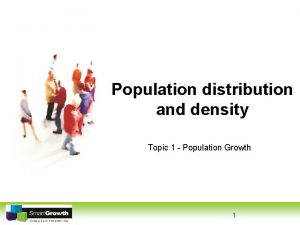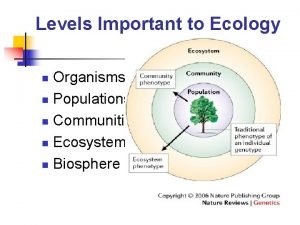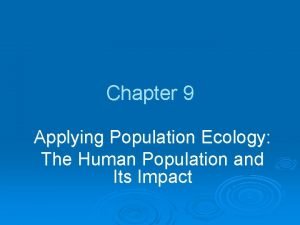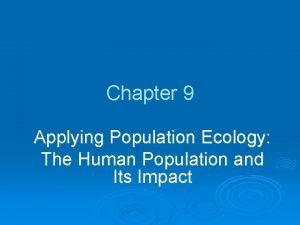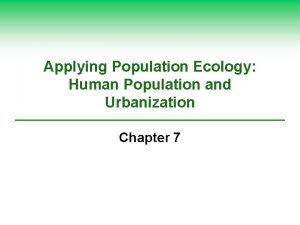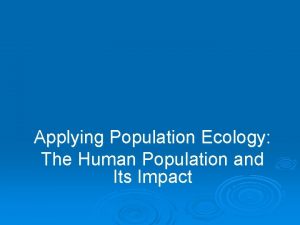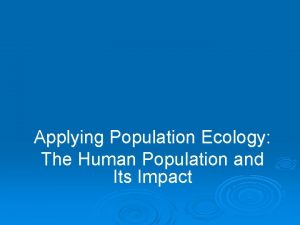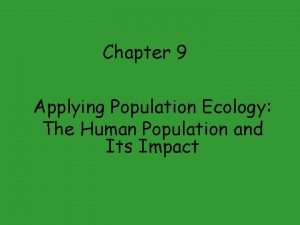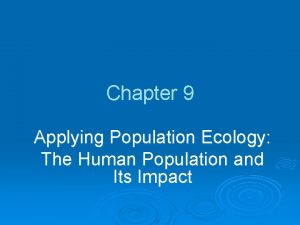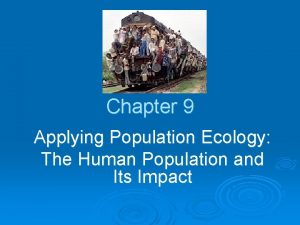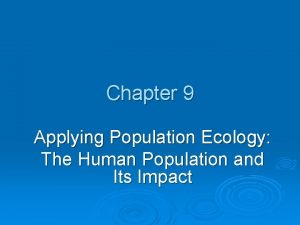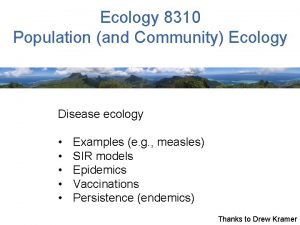Applying Population Ecology The Human Population G Tyler




















- Slides: 20

Applying Population Ecology: The Human Population G. Tyler Miller’s Living in the Environment 14 th Edition Chapter 10 (Pages 176 -192)

Key Concepts Ø Factors affecting human population size Ø Human population problems Ø Managing population growth

CASE STUDY: Thailand • 1971 Policy to reduce population - Before: 3. 2% GR, avg. family: 6. 4 children - After (1986): 1. 6% GR, avg. family: 1. 7 children • Programs initiated – Government supported family planning – High literacy rate among women – Increased economic role & advances for women’s rights – Better health care for women & children • Population and Community Development Association (PCDA) – – Non profit organization Helped government by supporting programs Handed out contraceptives at festivals, movies, traffic jams Developed ads & witty songs

Factors Affecting Human Population Size OBJ 10. 1 Ø Population change equation Population Change = (Births + Immigration) – (Deaths + Emigration) Ø Crude birth rate (CBR) - # live births per 1000 people in a population in a given year Ø Crude death rate (CDR) - - # live deaths per 1000 people in a population in a given year Refer to Figure 10 -3, p. 177

Average CBR and CDR

OBJ 10. 3 Describing Population Changes ØDoubling Times - time (years) for a pop. Growing at a specified rate to double in size Ø“Rule of 70” - - EX: 2004 world’s pop. growth rate 1. 2% doubling time = 70/1. 2= 56 years

GLOBAL FERTILITY OBJ 10. 4 Ø Fertility - # of births that occur to an individual woman or in an pop. Ø Replacement-level Fertility - # of children a couple must bear to replace themselves Ø Total Fertility Rate (TFR) - average # of children a woman may typically have during her reproductive years

UPS & DOWNS: US Fertility & Birth Rates • 76 mil (1900) to 294 mil (2004) BIRTH RATES IN THE US 32 30 28 26 24 22 20 18 16 14 0 1910 End of World War II Demographic transition 1920 Depression 1930 1940 Baby boom 1950 1960 Year Baby bust 1970 Echo baby boom 1980 1990 2000 2010

Factors Affecting Birth Rates and Total Fertility Rates Ø Children in Labor Force Ø Cost of raising and educating children Ø Availability of pension systems Ø Urbanization Ø Education and employment for women Ø Infant mortality rate Ø Average marrying age Ø Abortion Ø Availability of birth control

Comparison of Demographic Data

Typical Effectiveness of Birth Control Methods in US

Major Changes in US 1900 & 2000 OBJ 10. 5

OBJ 10. 7 Factors Affecting Death Rates Ø Life expectancy - avg. # years a newborn infant can expect to live Ø Infant mortality rate (IMR) - # babies out of every 1000 born who die before their 1 st birthday GOOD NEWS BAD NEWS Global life expectancy increased from Poorest least developed countries 48 years to 67 years (African countries) life exp. 49 years (76 developed 65 developing) IMR dropped from 20 per 1000 live births to 7 in developed countries IMR dropped from 118 per 1000 live births to 61 in developing countries

Immigration in the US • • • Countries encourage: Canada, Australia, US Account for 1% for growth rate in developed countries Accounts for 41% of country’s annual growth rate 1820 -1960 most were from Europe Since 1960 most are from Latin America (51%), Asia (30%), Europe (13%) • Largest minority group are Latinos • Concern: illegal immigration

OBJ 10. 9 Population Age Structure Male Female Rapid Growth Guatemala Nigeria Saudi Arabia Ages 0 -14 Slow Growth United States Australia Canada Ages 15 -44 Zero Growth Spain Austria Greece Negative Growth Germany Bulgaria Sweden Ages 45 -85+ Fig. 10 -14 p. 184

Solutions: Influencing Population Size OBJ 10. 11 Ø Migration Ø Environmental refugees Ø Reducing births Ø Family planning Ø Empowerment of women Ø Economic rewards and penalties

OBJ 10. 12, 13 The Demographic Transition Fig. 10 -20 p. 189 Stage 2 Transindustrial Stage 3 Industrial Stage 4 Postindustrial High 80 70 Relative population size Birth rate and death rate (number per 1, 000 per year) Stage 1 Preindustrial 60 50 Birth rate 40 30 Death rate 20 10 0 Total population Low Increasing Growth Very high Decreasing Low Zero growth rate growth rate Time Low Negative growth rate

Case Study: Slowing Population Growth in India Generally disappointing results: Ø Poor planning Ø Bureaucratic inefficiency Ø Low status of women Ø Extreme poverty Ø Lack of support

Case Study: Slowing Population Growth in China Ø Economic incentives Ø Free medical care Ø Preferential treatment Ø Locally administered Ø Very intrusive and coercive

Cutting Global Population Growth Ø Family planning Ø Improve health care Ø Elevate the status of women Ø Increase education Ø Involve men in parenting Ø Reduce poverty Ø Sustainability
 Population ecology section 1 population dynamics answer key
Population ecology section 1 population dynamics answer key Section 1 population dynamics answer key
Section 1 population dynamics answer key Population ecology section 1 population dynamics
Population ecology section 1 population dynamics Study guide section 1 population dynamics
Study guide section 1 population dynamics Population ecology example
Population ecology example Logistic growth equation population ecology
Logistic growth equation population ecology 52
52 Population vs community ecology
Population vs community ecology Concept 3 population ecology
Concept 3 population ecology Chapter 53 population ecology
Chapter 53 population ecology Chapter 36 population ecology
Chapter 36 population ecology Ecology
Ecology Lynx and hare relationship
Lynx and hare relationship Chapter 53 population ecology
Chapter 53 population ecology Characteristic of population
Characteristic of population Chapter 4 section 2 human population answer key
Chapter 4 section 2 human population answer key Population characteristics
Population characteristics What is population ecology
What is population ecology Population definition ecology
Population definition ecology Population ecology
Population ecology Parasitism pictures
Parasitism pictures



















